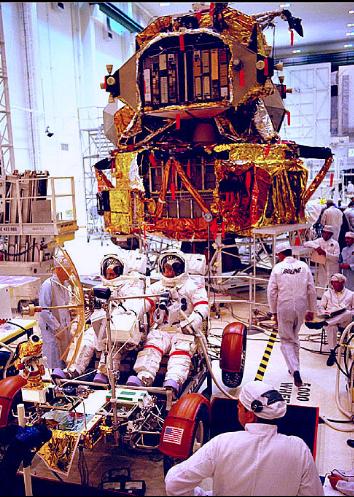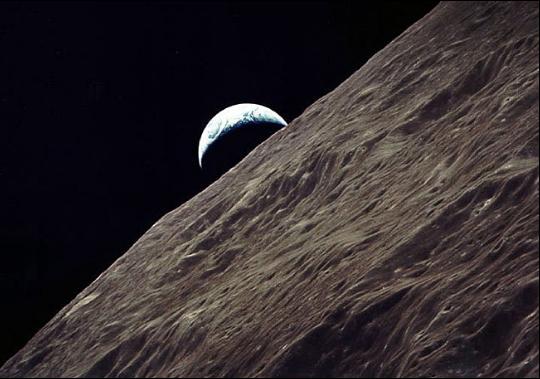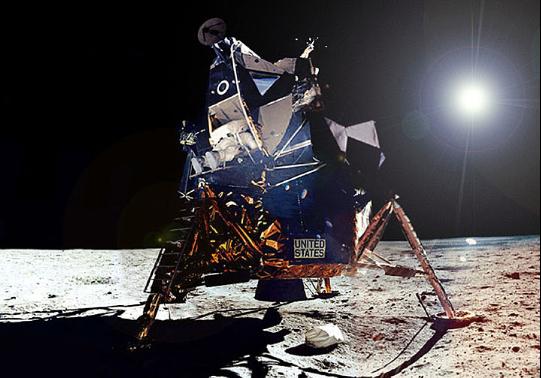 |
|||||||||||||||
STORY LINK: "In the Shadow of the Moon" on Space.com |
||
"In the Shadow of the Moon" The adventure of exploring another world is shown in a fascinating new documentary by Michelle Evans, September 2007
“It was a time when we made bold moves.” James Lovell, Apollos 8 and 13
Countless documentaries have attempted to capture the essence of what it was like to fly to the Moon during the glory days of the Apollo program. Some have been fairly successful, but usually still feature the standard talking heads and grainy umpteenth-generation film footage. One notable previous exception was Al Reinert’s 1989 work, For All Mankind. This was the first attempt to get Apollo footage onto a large theater screen, and is regarded favorably by most who had the opportunity to see it in that format.
Now, nearly 20 years later, we finally have a worthy successor in David Sington’s In the Shadow of the Moon. Unlike so much that has come and gone before, Sington has reinvented the Apollo documentary format. Where the earlier film left us wanting much more, this time around we finally get that which we’ve been waiting for so long. Beautiful and rarely seen footage has been taken from the archives at NASA, transferred to high-definition video, and given new life in a way never before imagined.
A large failing of Reinert’s film was that he glossed over the launch phase of the largest rocket booster ever to successfully fly: namely, the Saturn V. Sington, on the other hand, does the Saturn V proud. Numerous pieces of launch footage, including the spectacular top-of-the-gantry, wide-angle camera from the Apollo 17 night launch in December 1972, are highlights of Sington’s superb film.
Getting off the Earth was just the beginning. We follow the journeys of the astronauts as they cross cislunar space, drop down onto that forbidding surface, conduct scientific experiments that have laid the foundation for our present understanding of our place in the universe, then blast off the Moon to return to Earth. Yet even then, the journey is just beginning.
Speaking with numerous Moon Voyagers—at least one from each Apollo lunar mission—we hear their thoughts and feelings about their apocryphal experiences. These are not glossed-over propaganda statements, but heart-felt and honest reminisces from these astronauts, giving us insights that have never before been the subject of a space documentary.
We start with a statement by Apollo 16 astronaut Charlie Duke. He tells us how his father was of the era that had a hard time believing that anyone could voyage off this planet—especially his own son—but then Charlie tells us of his son and how walking on the Moon is just “no big deal.”
Not only do we get to see this Apollo footage as it has never been seen, and get to hear the astronauts express themselves as never before, but they have gone one step further by marrying the sound and film from Mission Control. We are all so familiar with the words spoken by Neil Armstrong as he stepped onto the dusty lunar surface, and the voice from Mission Control that answers him (Charlie Duke), so it may come as a surprise that all film footage inside Mission Control was silent. The producers found the audio loops and painstakingly matched the voices to film for the first time ever. This is a memorable feat that may go unnoticed by many viewers, but from a historical perspective, it is a welcome show of the diligence of the filmmakers of In the Shadow of the Moon.
Gene Cernan spoke of going “into darkness after being in daylight the whole time—and we’re in the shadow of the Moon.”
Cernan’s comment lent Sington the title of his movie, and it is a perfect one. Cernan has proven himself one of the most eloquent writers and speakers on his experiences. He tells us of what he thought when he heard President Kennedy commit America to a Moon landing in less than a decade: “He challenged us to do what I think most people thought was impossible, including me.”
And yet, Gene saw the dream Kennedy presented to our nation and hopped aboard for several memorable flights, including as commander of the last Apollo flight to touch down on the Moon, Apollo 17.
Jim Lovell is now most famous for being the commander of the ill-fated Apollo 13, but few remember he was also aboard the first flight beyond the confines of the Earth’s gravity, and into that of the Moon, Apollo 8. He tells us, “Just from the distance of the Moon, you can hide the Earth behind your thumb, everything that you have ever known; your loved ones, your business, the problems of the Earth itself, all behind your thumb. It makes you consider how insignificant we really are.”
Some of the more interesting comments come from an astronaut who never actually walked on the surface of the Moon, Apollo 11 Command Module pilot, Michael Collins. He tells the audience, “To me, the marvel of it is that it all worked like clockwork, I almost said like magic. There might be a little magic mixed up in that big clock somewhere, because everything worked as it was supposed to. Nobody messed up. Even I didn’t make mistakes. I have a lot of things I can do wrong, but the consequences, should I do them wrong, are going to be immediately obvious to three billion people.”
Once his mission was complete and their Apollo spacecraft had splashed down in the Pacific, Collins’ first reaction when the frogmen opened the hatch was how beautiful the deep blue water was on planet Earth. It was as if he was seeing it as an alien coming from another world, which, in a significant sense, he was.
The timing of this movie’s release is perfect in that it will be entering theaters around the country close to the 50th anniversary of the first-ever spaceflight (Sputnik 1). Serendipitous, to be sure, and hopefully the general public will take note and head for their theaters to relive, or see for the first time, what this magnificent adventure to another world was all about.
I have often talked of the fact that I was privileged to be witness to the beginning of the space program and the first human to walk on another world, but that those born afterward have had nothing of comparison in their lives. Moon landings are a few pages in the history books for them, they never were able to register the gut feeling of watching this happen in real time so many decades ago. With In the Shadow of the Moon, everyone alive today will get at least some of the feelings those of us of the Apollo generation got to feel first hand.
What better way to inspire the new generation for our return to the Moon and subsequent expansion into the cosmos than by giving them a shot of adrenaline from the pioneers who first took us there.
Six-time astronaut and Apollo 16 Moonwalker, John Young puts some of this in perspective when he tells us of his view from space. “There’s a lot of things like urban pollution, and you can see that when you hit orbit now. You can see that big cities all have their own set of unique atmospheres. We ought to be looking out for our kids and our grandkids. [Instead] what are we worried about? The price of a gallon of gasoline.”
Seeing our Earth from space, then moving beyond that, is one of the best ways to understand our home planet and to make it safe for future generations. After all, it was the views from space in the 1960s and early 1970s that launched the environmental movement. Without Apollo, would we have the global perspective we enjoy today? Only when you can block out an entire world of billions of people with your thumb, as Jim Lovell told us, can we truly see what we have to deal with.
In the Shadow of the Moon is the perfect primer for the entire world to tell us all how important space exploration is to our future as a species. Everyone should sit back and enjoy this film for exactly what it is, a celebration of Apollo, and also for what spaceflight can aspire to be again. XXXX |
||||||||
 |
||||||||
 |
||||||||
 |
||||||||
 |
||||
 |
||||